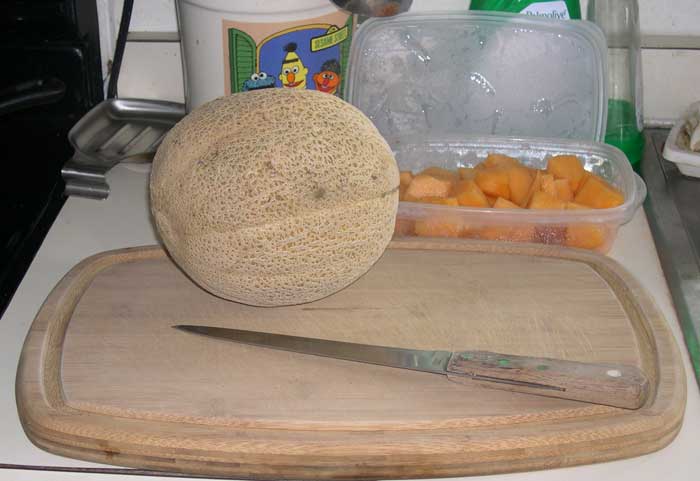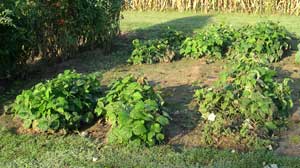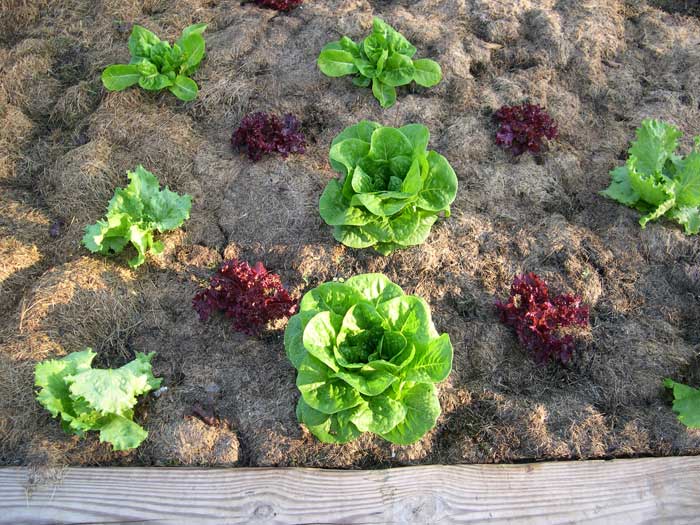One of the Joys of Maturity |

Custom Search
|
| Affiliated Advertisers |
Clicking through one of our banner ads or some of our text links and making a purchase will produce a small commission for us from the sale. The Old Guy's Garden Record
Putting up onions, peppers, and sugar snaps this way makes cooking with them really easy. We just grab a handful of whatever we need from the freezer bag. Our fall lettuce and brassicas growing under plant lights required some attention as well. Since I'd seeded more than one seed per cell, a good bit of transplanting was required to get to just one lettuce, broccoli, or cauliflower plant per cell. The transplanted plants went back under the plant lights, while the ones that weren't seriously disturbed went onto the back porch to harden off for a few days before going into the garden. Once the transplants had been moved to individual cells, things looked a bit less crowded under the plant lights.
It will be a full seven months before we see flowers from these gloxinias. I'll need to move them to individual cells in a few weeks where they'll grow for a month or so before going into four inch pots. And I guess I saved the best for last. I decided this morning to run out to our "extra garden" in a farmer's field next to us to check our vining crops. I didn't have the camera with me, so I can't show you full slip or half slip of cantaloupes. But I did pick two cantaloupes! For me, bringing in a crop of cantaloupe or watermelon without having to spray with Sevin or some other highly toxic product is a real high. I hope your Labor Day weekend has been as joyous and blessed as Annie and mine has been. I picked our first watermelon of the year last week. It weighed in at 28.6 pounds! It was ripe when I cut it, but I really should have let it sit another day or two before picking. Our cantaloupe are now coming fast and furious. Of course, once they play out, they're gone, but we still have a dozen or so on the vine. Lots of folks in central Indiana are having trouble with their tomatoes this year. I'd guess it may be due to the very wet spring we had. I waited until late May to transplant our tomatoes. They also were mulched immediately after transplanting. We've had a good harvest so far, but two of the rather top heavy cages blew over when the remnants of Hurricane Ike passed through yesterday.
I'd prepared both beds weeks ago when other crops had vacated the senior garden, adding peat, lime, and fertilizer to both planting areas. I then added a six inch layer of grass clippings over the beds and let them just sit and wait until the time, weather, and transplants were ready. Even with some good showers, I noticed dry spots remained under the mulch when I transplanted. Since I always add a little liquid starter fertilizer to transplants, I just gave them a bit more than usual. The heavy rains yesterday should get them well on their way.
Our sugar snap peas have just about played out for the year. I picked a grand total of just six pods the last time around. I usually get 30-50 in a picking, so I'd guess it's time to pull up the vines. Getting back to peppers, we couldn't grow good peppers on this ground for a long time. We kept trying each year, only to have the plants mysteriously die just as the blossoms turned into small peppers. Then about eight years ago, we started getting bountiful harvests of peppers each year. I'm still not sure what happened. I'd successfully grown peppers in other gardens before moving here. I didn't do any radical change to the soil, other than each year trying to increase the organic matter in the soil and periodically adding lime.
I worked for several years with an excellent special education teacher, David Hale. Dave was also an avid gardener, but had never grown zuchinni. He decided to try them and bought a whole flat of plants. He set them all out in his extensive garden. When harvest rolled around, if you left your car unlocked at school, you were likely to find a bushel of zuchinni inside at the end of the day! We're not filling co-workers cars with cantaloupe, as I planted only two hills of them. As with most other plants, a succession of harvest would have been nice. But, I'm not complaining. It was time again to turn the compost heap this week. The heavy rains over the last weekend had it thoroughly soaked. When I turned and moved it, I found that it was hot in the center as it should be. I also pulled up the sugar snap pea vines and piled them onto the heap. The compost pile also received a sprinkling of lime to keep it sweet and triple-12 fertilizer to keep it "cooking." Interestingly, around the edge of the compost heap where it doesn't heat up as much, I found seedling cucumbers from those that I tossed in earlier. While I did germination tests on the seed I saved from the Japanese Long Pickling variety, it was somewhat gratifying to see the seeds germinate. It also reminded me of the importance of turning and stirring the compost from time to time. Our fall lettuce is obviously doing well. I had to replace a couple of plants from apparent mole damage, and one appeared to have been nipped off from the top by a rabbit or deer. There's obviously more lettuce than the two of us can eat, but at this time of year, there's plenty of space. I like the contrast of the bright greens and reds of the lettuce as well.
I still use sterilized potting soil for the transplants at this stage. They're still succeptable to all kinds of ills, especially moss in the pot. I add a dash of Captan to hold the moss back as much as possible.
It is important to continue bottom watering gloxinas regularly. The soil can dry, but one needs to not let the plants totally dry out. If all of this seems to be a lot of trouble, let me share the photo at left with you. It's a flower type that I really don't think was part of our original plants. It was produced on a plant grown from seed we saved in my classroom. September 27, 2008 - Applesauce
The squeezo will take whole apples, although I remove the blossom end and split each apple before throwing them into the pot of apple juice to warm and soften. Splitting them is necessary for me, as these are all groundfall apples. Almost all of them have a small bruise from where they hit the ground that needs to be cut out. Recipes for applesauce are really unnecessary if all you want is just straight applesauce. Both the Squeezo cookbook and the Ball Blue Book Since apples are an acid fruit, you can safely water bath can them for 20 minutes. This batch from ten gallons of apples won't last long enough to make it worth getting the water bath canner out and cleaning it. (I think I used it last to sterilize some potting soil!) Our crew of kids (grown) and grandkids will make quick work of it. One note I might add that I noticed in one of the cookbooks is that using several varieties of apples improves the taste of the sauce. Since our Granny Smith tree died last year, I'm making our applesauce this year just from apples from our Stayman Winesape tree. I have already noticed that the applesauce, while good, isn't as good as it has been in past years when we've had more than one apple variety to sauce. A Friend in the Garden
September 28, 2008 - Fall Lettuce We enjoyed our first picking of fall lettuce (and a bit of spinach) in a salad for lunch today. I've planted far more fall lettuce than we can eat this fall. And on the odd chance that we might not have an early, killing frost, I planted a bit more today. As I've related before, I like how the lettuce looks in the garden (and in a salad or on a sandwich). Hummingbirds Most of "our" hummingbirds appear to have started their migration south for the winter. We still have a few visiting our feeders, although they seem much more shy than our summer-long residents. I moved our feeders in front of the windows on our porch so that we could enjoy the few migratory or late stayers that are still visiting the feeders. The hummingbirds had also become a potential hazard, zipping the length of the porch just missing our heads as they jostled for position at the feeders at opposite ends.
From the
at Senior Gardening |
| Affiliated Advertisers |
©2008 Senior-Gardening.com










 Our peppers are finally producing red, gold, and yellow fruit along with the standard green bell peppers. Annie made some great cheese and pepper omlets for lunch yesterday. And I just can't resist posting pictures of ripe peppers of various colors, as I think they're one of the prettiest things that comes out of the garden.
Our peppers are finally producing red, gold, and yellow fruit along with the standard green bell peppers. Annie made some great cheese and pepper omlets for lunch yesterday. And I just can't resist posting pictures of ripe peppers of various colors, as I think they're one of the prettiest things that comes out of the garden. Our bountiful harvest continues in the senior garden, with green beans, tomatoes, peppers, and melons. When I went out one day this week to check the melons, I found that ten cantaloupes were ripe! Such concentrated harvests can make one rather popular with friends, neighbors, family, and co-workers.
Our bountiful harvest continues in the senior garden, with green beans, tomatoes, peppers, and melons. When I went out one day this week to check the melons, I found that ten cantaloupes were ripe! Such concentrated harvests can make one rather popular with friends, neighbors, family, and co-workers.

 Some of our gloxinias started from seed last month were ready to be transplanted into four packs this week. I tease the soil and lift the plants with a knife, trying to preserve the unusually long "taproot" they often have. One can actually wait until the plants show a small corm at their base.
Some of our gloxinias started from seed last month were ready to be transplanted into four packs this week. I tease the soil and lift the plants with a knife, trying to preserve the unusually long "taproot" they often have. One can actually wait until the plants show a small corm at their base.





